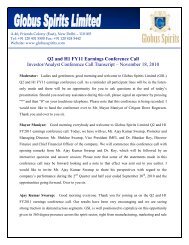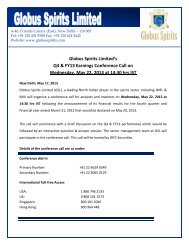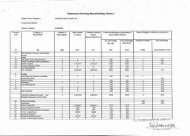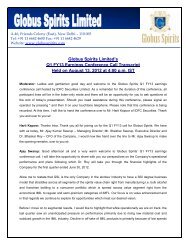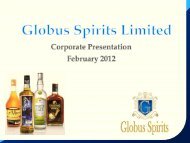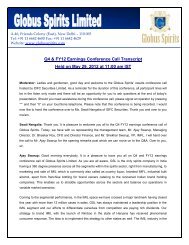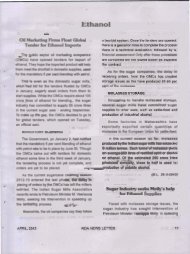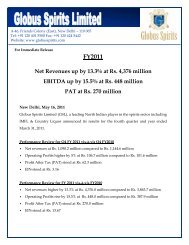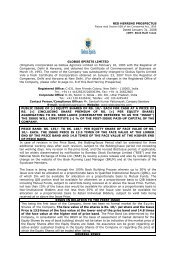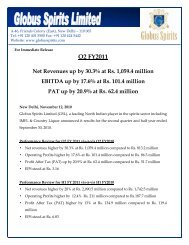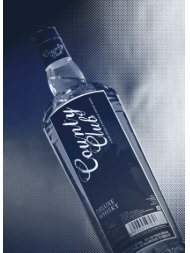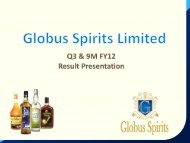RED HERRING PROSPECTUS Dated August 24 ... - Globus Spirits
RED HERRING PROSPECTUS Dated August 24 ... - Globus Spirits
RED HERRING PROSPECTUS Dated August 24 ... - Globus Spirits
Create successful ePaper yourself
Turn your PDF publications into a flip-book with our unique Google optimized e-Paper software.
Ethanol as a Fuel<br />
Ethanol is used as an automotive fuel by itself and can be mixed with gasoline to form what has<br />
been called "gasohol" FUEL ETHANOL- the most common blends contain 10% ethanol and 85%<br />
ethanol mixed with gasoline. Over 1 billion gallons of ethanol are blended with gasoline every<br />
year in the United States. Because the ethanol molecule contains oxygen, it allows the engine to<br />
more completely combust the fuel, resulting in fewer emissions. Since ethanol is produced from<br />
plants that harness the power of the sun, ethanol is also considered a renewable fuel. Therefore,<br />
ethanol has many advantages as an automotive fuel. (Source: www.ethanolindia.net)<br />
A major contribution to the improving prospects for the Brazilian alcohol industry has been made<br />
by flex fuel cars. These cars which are able to run on any mixture of hydrous and anhydrous<br />
alcohol as well as gasoline have proved to be enormously popular. Introduced in March, 2003,<br />
sales in the first 13 months (March/March) have risen to almost 95,000 units, which compares<br />
with 37,000 units for ethanol-only powered vehicles sold in the same period. Forecasts for the<br />
future development of sales are similarly optimistic. The Association of Car Manufacturers in<br />
Brazil – Anfavea – expects to see the market share of flex fuel vehicles rising to 23% by 2008.<br />
Meanwhile, all the country’s major car manufacturers have flex fuel engines in their ranges. As a<br />
result, the Association of Sugar Cane Growers in the state of Sao Paulo – Unica – anticipates<br />
total fuel alcohol consumption in Brazil rising to almost 17 billion litres by 2010 from the current<br />
11.5 billion litres. (Source: All India Distillers’ Association, July 2004, Volume IV, Issue 7)<br />
Risks and concerns/opportunities and threats<br />
In India, excise duty on alcohol is a State levy, not a Central levy and each State has its own<br />
control measures to determine the excise duty structure and also the distribution system of<br />
potable liquor. Moreover, inter-state sales of IMFL attract export duty in the state of<br />
manufacture and import duty in the state of sale. This results in high prices at the consumer<br />
level and acts as a big trade barrier. Therefore, for all practical purposes, a Company has to<br />
have a manufacturing set up of its own or a bottling tie-up in a State to sell in that particular<br />
State in order to maintain economic and commercial viability.<br />
State level levies prevent economies of scale, increase costs and inefficiencies, hamper growth<br />
and reduce government collections. Steps have been undertaken to introduce uniform excise<br />
duty across the States and revenue sharing agreement for all Inter-State sales. When these<br />
regulations are put in place, they will provide a stimulus for the growth of the liquor industry in<br />
India.<br />
The liquor industry is suffering from over-taxation and over-regulation, which has impeded the<br />
profitability even in the face of continuing growth in demand for liquor products. Further<br />
widening the scope of service tax and increase in the rate of service tax has had a direct impact<br />
by way of increased expenditure on the Company.<br />
Distribution of IMFL is also regulated in some states either through auctions or through<br />
government procurement agencies (as in Tamil Nadu and Andhra Pradesh etc.) These<br />
regulations create monopolistic environment, stifle entrepreneurship spirit and hamper growth.<br />
The present distribution system is affecting the revenue collections of the states, and the state<br />
governments are increasingly looking to liberalize the distribution system. Uttar Pradesh is a<br />
good case in point where the excise revenues witnessed a substantial jump once the distribution<br />
system was de-regulated in financial year 2001-02. Stagnating excise revenues (from liquor) are<br />
also forcing state governments to re-look at archaic systems.<br />
Recently, Madhya Pradesh and Rajasthan Governments had also de-regulated the IMFL<br />
distribution system to improve its revenue collections.<br />
The industry is also constrained to cope with a ban on advertising of products. Advertising, the<br />
most effective tool for building brands and communication about products has been denied to<br />
the liquor industry.<br />
Keeping with its commitment with WTO, The Government of India has been consistently<br />
reducing the import duty on foreign liquor and spirits, although some measures of protection<br />
have been granted by the imposition of countervailing duties. Lowering of duties has facilitated<br />
the entry of large liquor MNCs in India and the domestic brands are beginning to loose<br />
71




